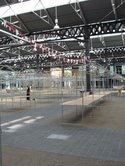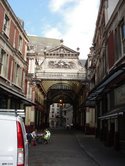We left the Arran House bright and early at 8am. Together, we boarded the tube and set off for East Aldgate in search of the Whitechapel Market. This proved to be much more of a hassle than we had imagined. As we left the station and entered the streets of Whitechapel, our first perception of the area was the large, pristine East London Mosque, featured below.

From that moment on, we observed many bilingual street signs (in Arabic and English) and small family owned businesses including flower shops, restauraunts, and news agents.

Though there were a plethora of shops, there was a distinct lack of people. We were perplexed by the quiet streets and closed stores and were still unable to locate the elusive Whitechapel Market. Thankfully, a mailman was able to calm our fears…by telling us that it did not exist. He instructed us to walk a few blocks to Commercial Street where we could visit Spitalfields, a predominantly Islamic market. This also proved to be a disaster: it was closed, as we later found out from Professor Qualls, due to the beginning of Ramadan. Below are a few pictures of the deserted market which we imagined, under different circumstances, would otherwise be a vibrant and exciting community.

This is the exterior of the Spitalfield Market!

Here is the interior of the deserted market.
After another panicked call to Professor Qualls, he then directed us to Leadenhall Market which we located on the outskirts of London Proper. Originally a market for fish and cheese mongers, it was established in 1321 as a meeting place for vendors. However in 1666, parts of the original building were destroyed by the Great Fire and then later rebuilt in both 1881 and refurbished in 1990.

This is the entrance into the Leadenhall Markets.
Below is an image that captures the amazing architecture of the market place which is clearly incredibly ornate and a far cry from what we saw in Whitechapel. Not only were there high-end retail stores, but also high-rises and the buildings and streets were noticeably cleaner.

Here is an example of Leadenhall Market's interior!
Despite the fact that the markets were closed, it was still a very enlightening experience, for we saw two different Londons. The first being a predominantly immigrant community that combined the traditional culture of their homelands with the western ideals of Britain. The second was a more commercialized section of the city and felt more like a mainstream city center. It lacked, however, the intimate nature of Whitechapel. All in all, this experience helped us realize the economic and cultural diversity of London!

0 responses so far ↓
There are no comments yet...Kick things off by filling out the form below..
You must log in to post a comment.